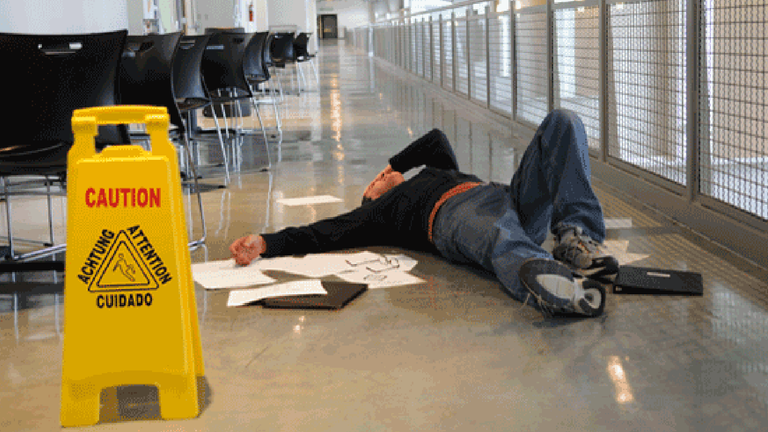Accidents involving injuries caused by poorly stocked merchandise causing injury are governed by the law of negligence in Rhode Island. They’re classified under the general ambit of premises liability causes of action. When they occur on property that’s owned or occupied by somebody else, that owner and/or occupier might be held liable, and the injured person might be able to recover damages for their injuries.
Common causes of falling accidents follow:
- Wet or hazardous surfaces- Most slip or trip injuries are caused by surfaces that are wet or otherwise hazardous from recent cleaning or waxing.
- Uneven surfaces- These might be uneven or cracked sidewalk slabs or otherwise uneven surfaces in poorly lit areas. They might also be potholes in pedestrian areas.
- Overstocked merchandise-Some merchants will overstock their aisles, and not give their customers sufficient room to walk around their stores. This clutter can create accidents.
- Loose floorboards and stairs-The pizza delivery kid can trip on either of these, particularly at night when he’s carrying a box.
- Torn or improperly stretched carpeting- Holes in carpets or lumps in them from years of use can cause trips, especially in areas with high use.
- Weather conditions
Many outdoor slips and trips are the result of accumulations of ice and snow. Assuming that the injured party is claiming that the owner and/or occupier of land was negligent, he or she will be required to prove each element of negligence. Those elements are:
- A duty to the injured party
- A breach of that duty
- That the breach caused the claimant’s injuries
- That the claimant suffered legally recognized damages
Accidents have occurred due to overstocked merchandise and torn carpeting in stores, resulting in injuries. Such incidents can pose serious safety risks to both customers and employees. To address and prevent these issues, here are some steps that can be taken:
- Inventory Management: Ensure proper inventory management to prevent overstocking. Regularly review and adjust stock levels based on demand, seasonality, and sales trends. Implement an efficient system for tracking and restocking inventory.
- Safety Inspections: Conduct regular safety inspections of the store premises. Identify and address potential hazards such as torn carpeting, loose flooring, or other safety concerns. Develop a protocol for promptly repairing or replacing damaged flooring.
- Employee Training: Provide training to employees on safety procedures and protocols. Ensure that they are aware of potential hazards and how to address them. Encourage employees to report safety concerns immediately.
- Customer Awareness: Place warning signs or barriers around areas with torn carpeting or potential hazards to alert customers. Educate customers about the importance of following safety guidelines within the store.
- Store Layout: Reconfigure the store layout if necessary to optimize the flow of customers and reduce the risk of accidents. This may include widening aisles, repositioning displays, or improving signage.
- Emergency Response: Develop and communicate clear procedures for responding to accidents or injuries. Ensure that first aid supplies are readily available, and employees know how to use them. In serious cases, call for medical assistance promptly.
- Record Keeping: Maintain detailed records of accidents and injuries that occur in the store. Analyze these records to identify patterns and take corrective actions accordingly.
- Legal Compliance: Ensure compliance with local building codes, safety regulations, and accessibility standards. Regularly review and update safety measures to meet or exceed legal requirements.
- Customer Feedback: Encourage customers to provide feedback on store conditions and safety concerns. Use this feedback to continually improve safety measures.
- Continuous Improvement: Establish a culture of continuous improvement when it comes to safety. Regularly review and update safety policies and procedures based on experience and evolving best practices.
By taking these steps, you can mitigate the risks associated with overstocked merchandise and torn carpeting in stores, ultimately creating a safer environment for both customers and employees. It’s essential to prioritize safety and proactively address any potential hazards to prevent accidents and injuries.
If the injured party in Rhode Island fails to prove any single element of negligence, their case fails in its entirety. The owner and/or occupier of the property ordinarily asserts one or more defenses. First, if it’s commercial property, they’ll argue that notwithstanding their due diligence there wasn’t enough time to discover the cause of the slip or trip before it happened. Next, they’ll argue that the claimant was comparatively negligent in not watching where they were walking. Given the nature of the claims and the defenses to them, slip and fall and trip and fall cases are complex. Claimants will want to retain a knowledgeable, experienced and successful Rhode Island personal injury attorney. Looking for an AFFF foam attorney?

